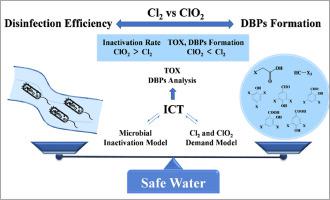当前位置:
X-MOL 学术
›
Water Res.
›
论文详情
Our official English website, www.x-mol.net, welcomes your feedback! (Note: you will need to create a separate account there.)
Comparison of chlorine and chlorine dioxide disinfection in drinking water: Evaluation of disinfection byproduct formation under equal disinfection efficiency
Water Research ( IF 11.4 ) Pub Date : 2024-06-12 , DOI: 10.1016/j.watres.2024.121932 Dongxiao Wang 1 , Xueyao Chen 1 , Jiayi Luo 1 , Peng Shi 1 , Qing Zhou 1 , Aimin Li 1 , Yang Pan 1
Water Research ( IF 11.4 ) Pub Date : 2024-06-12 , DOI: 10.1016/j.watres.2024.121932 Dongxiao Wang 1 , Xueyao Chen 1 , Jiayi Luo 1 , Peng Shi 1 , Qing Zhou 1 , Aimin Li 1 , Yang Pan 1
Affiliation

|
Disinfection efficiency and disinfection byproduct (DBP) formation are two important aspects deserving careful consideration when evaluating different disinfection protocols. However, most of the previous studies on the selection of disinfection methods by comparing DBP formation were carried out under the same initial/residual dose and contact time of different disinfectants, and such a practice may cause overdose or underdose of a certain disinfectant, leading to the inaccurate evaluation of disinfection. In this study, a comprehensive and quantitative comparison of chlorine (Cl) and chlorine dioxide (ClO) disinfection was conducted with regard to their DBP formation under equal disinfection efficiency. The microbial inactivation models as well as the Cl and ClO demand models were developed. On such basis, the integral CT (ICT) values were determined and used as a bridge to connect disinfection efficiency and DBP formation. For 3-log and 4-log reductions of , ClO had 1.5 and 5.8 times higher inactivation ability than Cl, respectively. In the premise of equal disinfection efficiency (i.e., the ICT ratios of Cl to ClO = 1.5 and 5.8), the levels of total organic chlorine, total organic bromine, and total organic halogen formed in the Cl disinfection were significantly higher than those formed in the ClO disinfection. Among the 35 target aliphatic DBPs, trihalomethanes (THMs) and haloacetic acids (HAAs) were the dominant species formed in both Cl and ClO disinfection. The total THM levels formed in Cl disinfection were 14.6 and 30.3 times higher than those in ClO disinfection, respectively. The total HAA levels formed in Cl disinfection were 3.5 and 5.4 times higher than those in ClO disinfection, respectively. Formation of the target 48 aromatic DBPs was much favored in Cl disinfection than that in ClO disinfection, and the formation levels was dominated by contact time. This study demonstrated that ClO had significant advantages over Cl, especially at higher microorganism inactivation and lower DBP formation requirements.
中文翻译:

饮用水中氯和二氧化氯消毒的比较:同等消毒效率下消毒副产物形成的评价
消毒效率和消毒副产物(DBP)的形成是评估不同消毒方案时需要仔细考虑的两个重要方面。然而,以往通过比较DBP形成来选择消毒方法的研究大多是在不同消毒剂的初始/残留剂量和接触时间相同的情况下进行的,这样的做法可能会导致某种消毒剂的剂量过量或不足,从而导致消毒评价不准确。本研究对氯(Cl)和二氧化氯(ClO)消毒在同等消毒效率下的DBP形成情况进行了全面、定量的比较。开发了微生物灭活模型以及 Cl 和 ClO 需求模型。在此基础上,确定了积分CT(ICT)值,并将其用作连接消毒效率和DBP形成的桥梁。对于 3-log 和 4-log 的减少,ClO 的灭活能力分别比 Cl 高 1.5 和 5.8 倍。在同等消毒效率的前提下(即Cl与ClO的ICT比分别为1.5和5.8),Cl消毒中形成的总有机氯、总有机溴、总有机卤素含量明显高于二氧化氯消毒。在 35 种目标脂肪族 DBP 中,三卤甲烷 (THM) 和卤乙酸 (HAAs) 是 Cl 和 ClO 消毒中形成的主要物质。 Cl消毒中形成的总THM水平分别是ClO消毒中的14.6和30.3倍。 Cl 消毒中形成的总HAA 水平分别比ClO 消毒中高3.5 倍和5.4 倍。 Cl 消毒比 ClO 消毒更有利于目标 48 种芳香族 DBP 的形成,且形成水平受接触时间的影响。这项研究表明,ClO 比 Cl 具有显着优势,特别是在较高的微生物灭活和较低的 DBP 形成要求方面。
更新日期:2024-06-12
中文翻译:

饮用水中氯和二氧化氯消毒的比较:同等消毒效率下消毒副产物形成的评价
消毒效率和消毒副产物(DBP)的形成是评估不同消毒方案时需要仔细考虑的两个重要方面。然而,以往通过比较DBP形成来选择消毒方法的研究大多是在不同消毒剂的初始/残留剂量和接触时间相同的情况下进行的,这样的做法可能会导致某种消毒剂的剂量过量或不足,从而导致消毒评价不准确。本研究对氯(Cl)和二氧化氯(ClO)消毒在同等消毒效率下的DBP形成情况进行了全面、定量的比较。开发了微生物灭活模型以及 Cl 和 ClO 需求模型。在此基础上,确定了积分CT(ICT)值,并将其用作连接消毒效率和DBP形成的桥梁。对于 3-log 和 4-log 的减少,ClO 的灭活能力分别比 Cl 高 1.5 和 5.8 倍。在同等消毒效率的前提下(即Cl与ClO的ICT比分别为1.5和5.8),Cl消毒中形成的总有机氯、总有机溴、总有机卤素含量明显高于二氧化氯消毒。在 35 种目标脂肪族 DBP 中,三卤甲烷 (THM) 和卤乙酸 (HAAs) 是 Cl 和 ClO 消毒中形成的主要物质。 Cl消毒中形成的总THM水平分别是ClO消毒中的14.6和30.3倍。 Cl 消毒中形成的总HAA 水平分别比ClO 消毒中高3.5 倍和5.4 倍。 Cl 消毒比 ClO 消毒更有利于目标 48 种芳香族 DBP 的形成,且形成水平受接触时间的影响。这项研究表明,ClO 比 Cl 具有显着优势,特别是在较高的微生物灭活和较低的 DBP 形成要求方面。
















































 京公网安备 11010802027423号
京公网安备 11010802027423号